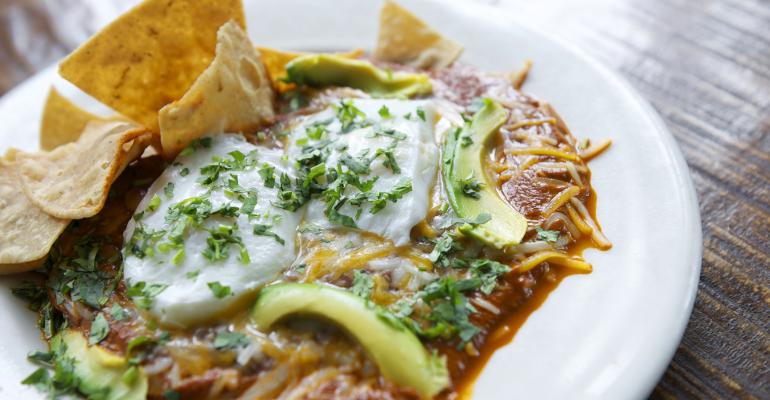Spiciness has traditionally been found on the table at breakfast and brunch. But often patrons splashed it on their food from a bottle or sipped it in a Bloody Mary. In recent years, however, menu makers have become increasingly intentional about incorporating ingredients with heat as fundamental elements of exciting breakfast and brunch fare.
What’s stoking the heat? It’s a combination of factors, including an increasingly diverse nation with a growing number of spicy food fans and a general consumer desire for more interesting dining experiences.
“Consumers crave foods that challenge their taste buds at a more sophisticated level than ever before, including new levels of hot, spicy, sweet, and savory,” notes the National Restaurant Association’s 2023 What’s Hot Culinary Forecast.
Furthering this trend is the creative cooking of chefs and restaurant operators moving into brunch as a business opportunity. “Many fine-dining restaurants that used to be open only at night are now serving weekend brunch,” says Shane Schaibly, corporate chef and senior vice president of culinary strategy at First Watch, a breakfast, brunch and lunch restaurant chain based in Bradenton, Florida.
In Schaibly's opinion, the skill and imagination of such chefs are portrayed in internationally inspired brunch items and innovative takes on classic American brunch dishes.
Exemplifying today’s livelier brunch fare is First Watch’s Sunny Seoul Hash, a limited-time offering running through January. It features seared pork, seasoned potatoes, diced red bell peppers, two kinds of cheese, eggs, and two notably zesty Korean ingredients—kimchi and gochujang. The latter, a paste of chilies and fermented soybeans, has its heat tempered by making it into an aioli sauce for the hash.
Finessing the heat
Schaibly notes that the heat is applied with finesse. It accents, not overwhelms, the other flavors. “We’re not trying to blow your socks off with Scotch bonnets or Carolina Reapers or anything too crazy,” he says.
Similarly, Million Dollar Harvest Hash, a previous First Watch LTO, uses a drizzle of Mike’s Hot Honey, a branded condiment, to intrigue guests’ palates. “That adds heat to a degree, but the sweetness and the heat together are what totally round out the dish,” says Schaibly.
Additional examples are found on the brunch menu of Red Rooster Overtown in Miami. Here, too, the emphasis is on using heat as an element of a varied flavor profile. The restaurant is a collaboration between celebrity chef Marcus Samuelsson, creator of the ground-breaking Red Rooster in New York City’s Harlem, and Grove Bay Hospitality Group of Miami.
Kenneth Gilbert, vice president of operations at Grove Bay, was charged with reflecting the spirit of Samuelsson’s Harlem restaurant while portraying the diverse culinary heritage of the Overtown neighborhood and the Miami community, notably African American, Caribbean, Latin, and Jewish.
The RR Benedict is a brunch dish typifying the restaurant’s cultural mix. The base of the Benedict is toasted challah bread, a nod to Miami’s Jewish community. Pulled oxtail meat, revered in Guyana and the West Indies, is the principal protein. The eggs are cooked sunny side up and napped with hollandaise sauce flavored with berbere, a lively spice blend fundamental to the cooking of Ethiopia, where Samuelsson was born. “It has a nice, medium-to-mild spiciness, nothing too aggressive,” says Gilbert. “It’s just good flavor.”
For those who wish to ramp up the heat, there’s the Red Rooster hot sauce Gilbert created with a base of Fresno chilies and pepper mash vinegar for the table.
Another brunch specialty, Jerk Smoked Salmon Toast, riffs on the cured fish traditions of Sweden, where Samuelsson grew up. “We buy a nice cured smoked salmon, put our house jerk rub on it, and throw it in the smoker,” says Gilbert. “It comes out tender and moist with a nice little bit of heat.”
Spicy sensations
At the University of Massachusetts-Amherst, the many international students who enjoy food with spicy sensations are sharing their enthusiasm with the campus at large, reports Robert Bankert, executive chef of residential dining for UMass Dining. One sign is the growing popularity of Indian-inspired, plant-based breakfast dishes with mild-to-medium spice levels, such as sambar, a stew of lentils and vegetables, and besan chilla, a savory chickpea flour pancake. “Although our students from southern India are constantly asking us to make it spicier, we have to keep the spice level approachable for all students,” Bankert says.
But not everyone believes public demand for heat is rising. “Honestly, I have not seen that change a ton,” says Michael Costa, concept chef of Zaytinya by Jose Andres, a Turkish, Greek ,and Lebanese restaurant with locations in New York City and Washington, D.C. “I think 5% to 10% of the customers who come in want extremely spicy food. Everybody else is kind of in the middle.”
Spice on the palate has been prominent at Beatrix in Chicago, a Lettuce Entertain You Enterprises restaurant, since it opened a decade ago, reports Marc Jacobs, executive partner and divisional president of the company. Brunch offerings like the Pineapple Habanero Margarita, Spicy Bloody Mary, and peppery brown sugar bacon from then are still popular today. Contemporary examples include the Hot Honey Fried Chicken Sandwich, Shakshouka with spicy tomato sauce, and the Bacon, Cheddar and Egg Sandwich with sriracha aioli.
“People definitely want more flavorful, spicy foods,” says Jacobs. “Although we've been doing it for 10 years, I think we are seeing more of it now.”
Can heat be overdone? “Personally, I like heat, but I also like to taste the flavors of what I'm eating,” says Jacobs. “So it is necessary to have a balance so you’re not serving people something so hot it stops them from enjoying what they eat next.”

